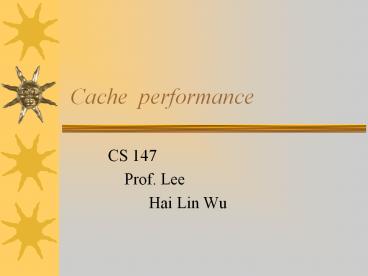Cache performance PowerPoint PPT Presentation
1 / 20
Title: Cache performance
1
Cache performance
- CS 147
- Prof. Lee
- Hai Lin Wu
2
Cache performance
- Introduction
- Primary components
- Cache hits
- Hit ratio
- Cache misses
- Average memory access time
3
Why we use cache memory in a computer?
- The primary reason
- to improve system performance by reducing the
time needed to access memory.
4
Cache hits
- Definition
- Every time the CPU accesses memory, it checks the
cache. If the requested data is in the cache, the
CPU accesses the data in the cache, rather than
physical memory this is a cache hit.
5
A simple example
- Every time CPU access memory it checks cache
first. - CPU
- check accesses data
- (not in cache)
Physical memory
cache
6
Cache misses
- Definition
- If the data is not in the cache, the CPU accesses
the data from main memory(and usually writes the
data into the cache as well). This is a cache
miss.
7
Hit ratio
- Definition
- The hit ratio is the percentage of memory
accesses that are served from the cache. - Hit Ratio of hits / total Strings
8
Average Memory access time
- Symbol
- TM
9
Formula for TM
- TM hTc (1 h) Tp
- Tc cache access time
- Tp physical memory access time
- h -- hit ratio
- (Note Tc and Tp are always given)
10
Relationship between Hit ratios and Average
memory access times
- Table
- So, increase the hit ratio reduce the average
memory access time.
h 0.0 0.1 0.2 0.3 0.4 0.5 0.6 0.7 0.8 0.9 1.0
TM (ns) 60 55 50 45 40 35 30 25 20 15 10
11
Calculating the H and TM
- We will learn how to calculate the H and TM with
two different type of cache - associative cache (FIFO)
- two-way set-associative cache(LRU)
- Besides, there is a direct mapped cache
12
Example of associative cache (FIFO)
13
Example cont.
- Given Tc 10ns Tp 60ns
- From the previous table we get
- hits 7 inputs 18
- h(hit ratio) hits/ inputs
- 7/18 0.389
- TM h Tc (1 h) Tp
- 0.8910 (1 - 0.389) 60
- 40.56 ns
14
Two-way associative set- associative cache(LRU)
- Hit ratio h 0.389
- TM 40.56 ns
15
A simple example for LRU
- Since the example from book is kind of hard to
understand, we can see the following simple
example.
16
Simple example of LRU
- 3 frame
- 10 inputs
- 1, 2, 3, 0, 2, 3, 1, 3, 0, 4
17
Construct a table
- Table
Data 1 2 3 0 2 3 1 3 0 4
1 2 3 0 2 3 1 3 0 4
1 2 3 0 2 3 1 3 0
1 2 3 0 2 2 1 3
Hit
18
Direct mapped cache
- The hit ratio h 0.167
- The TM 50.67 ns
19
The End!!
20
BUT You have to remember
- How to set up the table for FIFO and LRU
- How to calculate
- Hit Ratio
- Average memory access time
- Gook luck on finals!!

